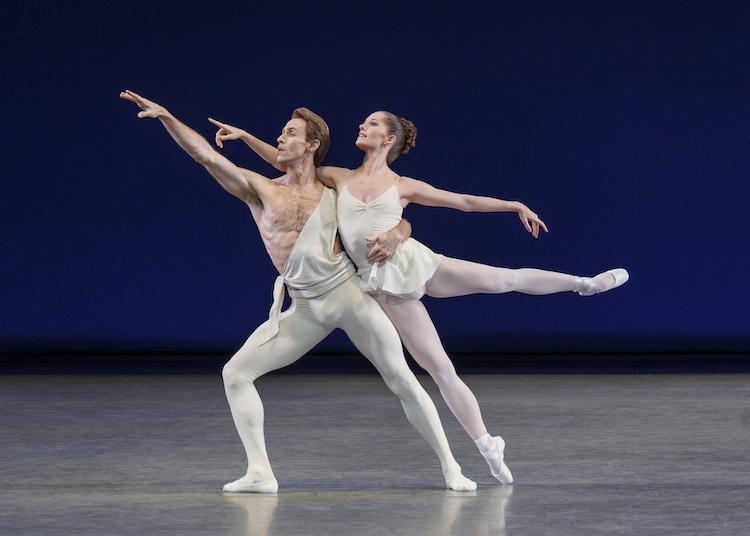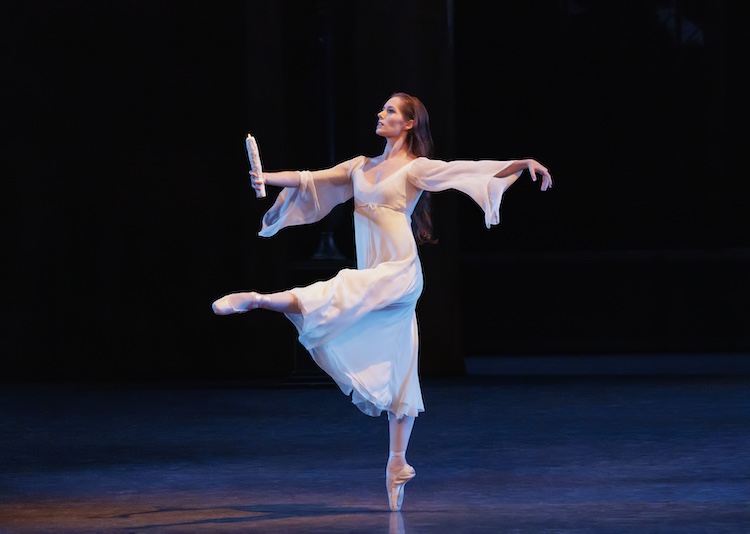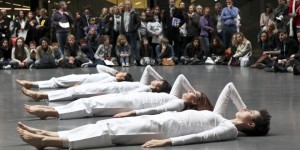IMPRESSIONS: New York City Ballet's 75th Anniversary Season with Balanchine and Robbins

New York City Ballet's 75th- Anniversary Season
September 19 – October 15,2023
Week 3 – Choreography: George Balanchine & Jerome Robbins
David H. Koch Theater, Lincoln Center, New York City
October 4 and 5, 2023
Week Three of New York City Ballet’s four-week, fall 75th anniversary season continued with its musicians formally on strike, but playing for every performance, nevertheless, in order not to bite the hand that feeds them. As of the publishing date of this article no agreement has been reached.
A repertory program of ballets by George Balanchine opens with the abbreviated version of his early success Apollo, which premiered as Apollon musagète. Igor Stravinsky is not only responsible for the music score, but also for the work’s libretto, which features the Greek god and three muses, namely Polyhymnia, Calliope, and — in a star turn — the muse of dance, Terpsichore.

Adrian Danchig-Waring in George Balanchine’s Apollo. Photo: Erin Baiano
You might be surprised to read that Balanchine’s June 1928 Paris premiere for Diaghilev’s Ballets Russes was not the ballet’s first arrangement. Dancer/choreographer Adolph Bolm had created his own version for the Washington Festival; and he starred as Apollo a month and a half before in a now largely forgotten portrayal. Elise Reiman, who starred as Terpsichore in Balanchine’s first US production in 1937, was also one of the muses in Bolm’s version alongside Ruth Page and Berenice Holmes.
Apollo dances and instructs the muses, who each dance a solo variation before he concentrates on Terpsichore in a long duet. Then he takes the three muses to Mount Parnassus, which becomes their home. At least that’s what he used to do. In Balanchine’s later version that mountain is only implied. That Apollo gave Orpheus a lyre on this mountain is the start to another ballet (to be reviewed next week); and that Apollo had the hots for Thalia - rather than Terpsichore – might be another ballet in the future.

Adrian Danchig-Waring exemplifies the company’s style. Clean lines and beauty of motion convey the storyline. His interest in Terpsichore, gracefully personified by Unity Phelan, is unveiled in the choreography. Emily Gerrity and Sara Adams convince with technical precision and musical acuity.
The beauty of the work’s final image, with Apollo gesturing the way up the (now imaginary) mountain and the muses leaning on him in arabesque poses of different height creating a sunburst effect, is a deeply memorable one.
As the title character in La Sonnambula, Phelan pretends to sleepwalk through what arguably might be Balanchine’s most poetic ballet. The way she gently sways and seemingly lets the night wind and the moonlight guide her movements belies her steely balance and strength. No wonder Taylor Stanley (as the Poet) is entranced by her, which, in turn, makes Ashley Laracey (Coquette) so jealous that she initiates a sequence of events that ends in murder. Daniel Ulbricht as the jester with high-flying jumps and expert comic timing ensures that the ballet is not a downer. Phelan gets the dead poet “to go” and carries him off stage.

A grand ballet in a more traditional style closes the evening. Tschaikovsky Piano Concerto No.2 premiered in 1941 as Ballet Imperial, performed by Balanchine’s touring Ballet Caravan in Rio de Janeiro. Having been in love with the ballet’s ballerina, Marie-Jeanne, Balanchine celebrated her technique and made many moments when the male protagonist yearns for her while she is offstage. But there is more: a juicy role for a female soloist who is supported by not one but two boys (it frames her better) and plenty of joyful precision dancing by a large cast that travels the stage. Tschaikovsky’s concerto in G Major premiered in 1879; and while Balanchine’s ballet is seen as yet another tribute to Marius Petipa, his update in 1973 for Patricia McBride, Peter Martins, and Colleen Neary concentrates on physical vigor and excitement rather than stately ceremony. The fast tempi of NYCB’s adaptation sweep and carry dancers and audience along. Sara Mearns is secure in her technique and expertly as well as lovingly partnered by Tyler Angle, so that she occasionally allows herself to take risks. It’s exciting when she does. Emily Kikta in the soloist role dances carefree and owns the stage. The corps de ballet visibly delights in the work’s challenges. Of the many Balanchine ballets that celebrate classical tradition, his Tschaikovsky Piano Concerto No. 2 is definitely one of the most satisfying.

Tyler Angle and Sara Mearns in George Balanchine’s Tschaikovsky Piano Concerto No. 2. Photo credit: Erin Baiano
The company’s fall gala the following evening is a high-fashion affair on and off the stage. Gowns in the audience and newly designed costumes for Balanchine’s Who Cares? by Wes Gordon (for Carolina Herrera) are a feast for the eyes. The new dresses for the jazzy ballet to Gershwin tunes are longer than the originals, but Gordon cuts them in a way that allows for movement and shows plenty of leg. Gorgeous! The ballet presented in excerpts by a cast of principal dancers brings the audience to its feet. Megan Fairchild, Tyler Angle, Isabella LaFreniere, Ashley Bouder, Chun Wai Chan, Tiler Peck (in an outstanding Fascinating Rhythm), Mearns, Andrew Veyette, and the especially excellent Joseph Gordon, all give plenty of reasons to cheer. Accompanied by Patti LuPone, Vanessa Williams, and Joshua Henry, conductor Andrew Litton has his hands full to keep the orchestra, singers, and dancers together, but – most importantly – he makes it work.

New York City Ballet in George Balanchine’s Who Cares? during the 2023 Fall Fashion Gala with costumes by Wes Gordon for Carolina Herrera. Photo: Erin Baiano
The freshest breeze during this otherwise all-Balanchine season proves to be a contribution by Jerome Robbins. The focus on Balanchine, however diverse his works may be, shows that NYCB is richer when additional choreographic voices contribute.

Robbins’s Glass Pieces is communal and the opening scene to Philip Glass’s driving music feels like a stroll through the busy streets of New York. Here is a depiction of urban drive and youthful energy that still feels modern forty years after its premiere. The work’s central pas de deux lets Phelan and Danchig-Waring explore a private, meditative state before the company explodes with great bursts of energy in the work’s finale. Here Robbins fails to build sequentially and lets the energy drop when the women of the company take over the stage, after the men transverse it in any direction one can think of. No matter, - once the men rejoin, the excitement grows, and the ballet electrifies the bejeweled gala audience.









![IMPRESSIONS: Will Rawls' “[siccer]” at the Keith Haring Theatre at Performance Space New York](/images/features_large/20251119_WillRawls_siccer_PerformanceSpaceNY_WhitneyBrowne--55.jpg)


